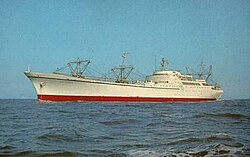Savannah (ship, 1962)
|
The Savannah at sea
|
||||||||||||||||||||||||
|
||||||||||||||||||||||||
|
||||||||||||||||||||||||
|
||||||||||||||||||||||||
|
||||||||||||||||||||||||
The Savannah was a combined ship put into service in 1962 . After the icebreaker Lenin, it was the second civilian ship with nuclear propulsion and the first nuclear-powered ship to be tested as a merchant ship.
history
Planning and construction
The ship was commissioned by the US government in 1955 as part of the Atoms-for-Peace initiative and was launched on July 21, 1959 in Camden , New Jersey , at New York Shipbuilding . The ship's godmother was the first lady at the time, Mamie Eisenhower .
period of service
The Savannah was finally put into service in August 1962 and operated by the shipping company American Export and Isbrandtsen Lines on behalf of the United States Maritime Commission . It was powered by a pressurized water reactor from Babcock & Wilcox , which provided the steam for the 22,000 hp (maximum output) turbines. Two diesel generators were available for emergency operation .
An agreement was concluded between Germany and the USA to regulate the safety regulations when calling at German ports.
In 1969 the ship anchored in the port of New York to be viewed by tourists on the occasion of Nuclear Week in New York .
The Savannah was designed as a combined cargo and passenger ship , but the focus was on testing nuclear propulsion. Therefore an economical operation was not possible and in 1972 the ship was decommissioned. By then the Savannah had covered 450,000 nautical miles .
Museum ship
After being in active service, the ship has been used as a museum ship since 1981 after several years of lay-in . The Savannah was listed as a structure on the National Register of Historic Places in November 1982 . The reactor was removed in the 1990s. As of 2006, the Savannah in Newport News , Virginia was overhauled. She has been in the port of Baltimore since 2008 .
The Ministry of Interior of the United States has the Savannah in July 1991 as a National Historic Landmark classified. The ship had a total of 46,900,000 USD cost (18.6 million USD for the ship and 28.3 million USD for reactor and fuel).
literature
- Tony Gibson: The world of ships . Basserman Verlag, 2007, ISBN 978-3-8094-2186-3 , page 205
Web links
- US Maritime Administration Virtual Office of Acquisition - Savannah (English)
- National Historic Landmark Nomination of Savannah (English, PDF, 267 KiB)
Individual evidence
- ^ Report of November 30, 1962 in the Weser-Kurier , page 10
- ^ Robie S. Lange: Maritime Heritage of the United States NHL Theme Study - Large Vessels: NS Savannah Theme Study ( English , PDF) National Park Service. August 1990. Retrieved April 8, 2017.
- ↑ SAVANNAH (nuclear ship) in the National Register of Historic Places , accessed March 8, 2020.
- ↑ Listing of National Historic Landmarks by State: Maryland. National Park Service , accessed March 8, 2020.
Coordinates: 37 ° 8 '20 " N , 76 ° 38' 37" W.


